Abstract
Utilising the properties of quantum mechanics, i.e., entanglement, parallelism, etc., a quantum structure is proposed for representing and manipulating emotion space of robots. This quantum emotion space (QES) provides a mechanism to extend emotion interpretation to the quantum computing domain whereby fewer resources are required and, by using unitary transformations, it facilitates easier tracking of emotion transitions over different intervals in the emotion space. The QES is designed as an intuitive and graphical visualisation of the emotion state as a curve in a cuboid, so that an “emotion sensor” could be used to track the emotion transition as well as its manipulation. This ability to use transition matrices to convey manipulation of emotions suggests the feasibility and effectiveness of the proposed approach. Our study is primarily influenced by two developments. First, the massive amounts of data, complexity of control, planning and reasoning required for today’s sophisticated automation processes necessitates the need to equip robots with powerful sensors to enable them adapt and operate in all kinds of environments. Second, the renewed impetus and inevitable transition to the quantum computing paradigm suggests that quantum robots will have a role to play in future data processing and human-robot interaction either as standalone units or as part of larger hybrid systems. The QES proposed in this study provides a quantum mechanical formulation for quantum emotion as well as a platform to process, track, and manipulate instantaneous transitions in a robot’s emotion. The new perspective will open broad areas, such as applications in emotion recognition and emotional intelligence for quantum robots.
1. Introduction
Emotional intelligence is primarily concerned with the capacity of an entity (human or robot) to exhibit, control, and express emotions and the ability to handle interpersonal (i.e., human-human, human-robot, or robot-robot) relationships judiciously and empathetically. Accomplishing this entails discerning between different emotions, labelling them appropriately, using them to guide thinking and behaviour, as well as managing and/or adjusting emotions to adapt to changes in environment, situations, and scenarios [1].
The intrigues required to model such multi-variate and continuously-changing feelings make descriptions of emotional state and their often-wavering transition from one state to another a very daunting exercise. To mimic the uncertainty related to emotions and their transitions, the notion of emotion space is used. An emotion space is used to quantitatively and visually imitate a human or robot’s emotions as it interacts with itself, others, and its environment over some interval in time [2]. Our review of the timeline for use of emotion space in emotional intelligence kicks off with Russel’s work from 1997, wherein a pleasure-arousal (PA) judgement space was proposed as a psychological judgement space for assessing affective feelings [3]. In that study, two dimensions were associated with the general characteristics needed to represent both the specific emotion as well as their continuous variation. Therefore, each emotion could be placed in the resulting PA space when emotion-eliciting factors are translated into appropriate values in the coordinate system. In 2001, a three-dimensional space was used to define as a mental model for a robot based on the PA space [4]. A certainty axis, which is a continuously varying value in the range −1 to +1, was added to this new space to produce smooth and effective communication between humans and robots. Subsequently, considering the rapid variation in mental state due to real-time human-robot interaction, an affinity-pleasure-arousal space was proposed in [2]. In this model, the affinity axis was used to describe the transition from one mental state to another as dictated by the progress in the conversation and repetitive interaction. The pleasure-displeasure and arousal-sleep axes in the space are related to the happiness of interlocutor as well as the liveliness in the dialogue, respectively. In 2013, Liu et al. proposed the concept of fuzzy atmosfield (FA) to represent the atmosphere created during interactive communication involving many humans and/or roots [5]. This study employed a 3D fuzzy cubic space to represent the sates of the FA where the three coordinates are defined as “Friendly-Hostile”, “Lively-Calm”, and “Casual-Formal” within the range −1 to +1.
Most of the available representations and discussions on emotion space in the literature [6,7] are formulated using conventional arithmetic, relying purely on the use of mathematical expressions and computation. The uncertainty, instantaneous and infinitesimal nature of emotions and their transitions suggest that a more rigorous and superior framework is required to efficiently decipher emotional intelligence. Exploiting the overwhelming superiority that quantum information processing offers [8], the potential to realise more powerful and efficient operations were explored. In [9], Lukac et al. provided a quantum mechanical model of robot-specific emotions based on quantum cellular automata. To facilitate this, they described a robot as a set of functional agents, each acting on behalf of its own emotional function; hence, generating the whole robot emotional state. Years later, Raghuvanshi et al. proposed the concepts that apply quantum circuits to model fuzzy sets, thereby creating a new method to model emotional behaviors for a humanoid robot [10]. This new method makes use of the entanglement and partial measurement properties from quantum mechanics available to the modeling of fuzzy systems to evolve behaviours of humanoid robots with a genetic algorithm [11]. These works are treated as the pioneering results in quantum emotion studies, although, neither of them provides a specific mathematical formulation to describe the quantum emotion and its space. In [12], Yan et al. formulated a quantum Bloch sphere-based representation for emotion space, where two angles and in the Bloch sphere were used to represent the emotions of robots and its intensity (or strength), respectively. However, since emotion and intensity were stored in a superposition state, the study could not offer a concrete information retrieval protocol to recover the available information about the robot’s emotion(s).
In this study, we propose a reformulated emotion space but as a prelude to that, we pause to ponder over two questions: (1) what are the quantum mechanical properties that could support effective expression of emotion? and (2) how does this “quantumness” relate to the description of a quantum robot (or qubot)?
While there are others, answering these two questions as well as exploring the integration of some of the remarkable advances recorded in quantum image processing [13,14] to descriptions of emotion space and emotional intelligence provide few of the motivations for this study. Now, we proceed to answer the questions posed earlier. First, employing quantum mechanics to describe emotion space presupposes the potential use of lower computing resources (since quantum parallelism offers exponential speed up relative to the required number of qubits as well as the sufficient (polynomial) number of CNOT gates that are needed to manipulate a quantum emotion, which sharply decreases the computational complexity of the process) and also quantum mechanics ensures that all transformations are unitary and reversible, so that the robot’s emotion could be easily transferred (forward or backward) within the emotion space. Regarding the second question that was posed earlier, by envisioning a qubot as a mobile quantum system that includes an on-board quantum computer and its required ancilliary systems [15], it is reasonable to imagine that qubots will carry out tasks whose goals include specified changes in conformity with the state of the environment or even carrying out measurements on the environment itself [16,17]. Moreover, it is envisioned that future robots will operate in all kinds of environments: manipulating, controlling, and interacting with different sensors, which themselves capture massive amounts of data. Furthermore, the invigorated interest in and funding for quantum computation suggests that the quantum era is upon us [18] and inevitably quantum hardware will play one role or the other in future robot communication be it as standalone units or as part of larger sophisticated hybrid systems. In tandem with these projections, presently, quantum technologies have been employed to improve the capability of conventional computing tasks by assuming their coalescence as peripherals of other sophisticated classical computing hardware [19]. Similarly, integrating quantum mechanics into descriptions of emotion space supports the development of qubots as well as its use to manipulate classical robot devices to perform advanced emotion-related actions [20]. The first step in exploiting the superlative properties of quantum computation in robotics is formulating its representation within the precepts of quantum mechanics.
Consequent upon the foregoing, in this study, we propose a layout to depict the quantum emotion space (QES) by utilising three entangled qubit sequences to locate an emotion point within a three-dimensional emotion space. From this, two qubit sequences will be allocated to elicit the type of emotion, while the remaining sequence will be dedicated for ascertaining the temporal information related to each emotion. In QES, a robot’s quantum emotion at each instance is a unique point in an emotion space, whereas the trajectory of a time interval produces a curve that depicts changes in the emotion with time. As conceived, the QES is an intuitive and graphical visualisation of the quantum emotion state as a curve in a cuboid which facilitates simple manipulations to the emotion state by identifying a “sensor” to track the emotion transition. To further elucidate and validate the proposed approach, we assess our proposed QES in terms of conformity with the rudiments required to retrieve an emotion in form of a physical quantum state.
The remainder of the paper is organised as follows. As a prelude to our discussion on the quantum emotion plane and QES, we present, in Section 2, a brief background on quantum computation (QC). In Section 3, the quantum structure of our proposed emotion space including its representation and procedures to track emotion transition are presented. In Section 4, we discuss the stratagem for emotion manipulation as well as intricacies related to the interaction between the system and the non-quantum (or classical) world. We complete the section by presenting a well-thought-out example that demonstrates execution of the whole QES process.
2. Preliminaries of QC and Emotional Plane
This section highlights the rudimentary knowledge about QC and the emotional plane, two core aspects of our proposed study.
2.1. Quantum Bits and Quantum Gates
The state of a quantum system is described as a vector in a Hilbert space, which is called a ket in quantum mechanical notation [8]. The ket and its adjoint, i.e., the bra notation, are defined as:
where is the notation of complex conjugate of u.
The smallest unit of information in a quantum system is a qubit (analogues to the digital binary bit), which is a unit vector in two-dimensional Hilbert space defined by:
where and are complex numbers.
The notation for the tensor product, ⊗, is used to express the composition of quantum systems. The tensor product of two matrices is defined as follows:
The short notation for tensor product of two vectors or two kets, and , is or and is used to denote the tensor product of a matrix A for n times.
In the quantum circuit model of QC, a complex transform is broken down into simpler gates such as the commonly used NOT, Hadamard, CNOT, and Toffoli gates [8] which are shown in Figure 1. A gate that acts on k qubits is usually represented by a unitary matrix, where the number of qubits in the input and output of the gate must be equal.
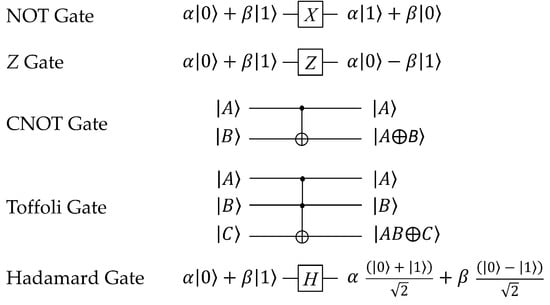
Figure 1.
NOT, Z, CNOT, Toffoli, and Hadamard gates.
The final step in quantum simulation is the measurement operation, which converts the quantum information into the classical information in form of probability distributions. This operation converts a single qubit state into a probabilistic classical bit M (distinguished from a qubit by drawing it as a double-line wire as shown in Figure 2), which is 0 with probability or 1 with probability .

Figure 2.
Single qubit measurement gate.
A projective measurement is described by an observable, M, a Hermitian operator on the state space of the system being observed [8]. The observable has a spectral decomposition that is described in the form presented in Equation (6):
where is the projector onto the eigenspace of M with eigenvalue m. The possible outcomes of the measurement correspond to the eigenvalues, m, of the observable. Upon measuring the state , the probability of recovering a result m is given by:
Given that the outcome m occurred, the state of the quantum system immediately after the measurement becomes:
2.2. Modified PA Plane
As highlighted earlier, traditionally, the PA plane is employed to visualise both a robot’s emotional data [3] and its interplay with other variables, such as the environment as well as other robots involved in the communication. This intuition arises from the established observation of the role pleasure and arousal emotions play in facilitating the robot construction of “psychological judgment space”. Additionally, the emotion-eliciting factors such as facial remarks, words, tone of voice, posture, or action can be represented by an emotional state in the PA space [21,22].
The two-dimensional PA plane is characterised by a pleasure-displeasure axis and an arousal-sleep axis, which represent not only specific emotions but general features common to many different emotions [3]. Moreover, unlike the expression of sensitive feelings in human communication, discussions pertaining to robot emotion are relatively straightforward. Hence, we modify the original PA plane in [3] and represent it as presented in Figure 3. Furthermore, the intersection between these two axes (henceforth called the cross point) is regarded as the neutral expression from which the level of happiness will increase along the pleasure direction, and vice versa. On the arousal-sleep axis, the liveliness of a human emotion will become stronger from the cross point towards the arousal axis. As seen in the figure, there are four quadrants that are labelled as “Excitement”, “Stress”, “Depression”, and “Calm”. Since our study is focused on the robot emotion, each quadrant of the modified PA plane can be roughly divided into four key emotions as illustrated in Figure 3.
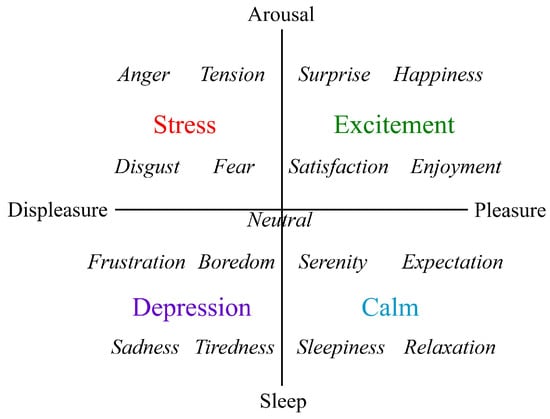
Figure 3.
Modified PA plane with four emotional quadrants.
3. Quantum Structure of Emotion Space
Building on the descriptions of emotion space and the modified PA recounted earlier, in this section, we introduce the layout of our proposed interpretation of the PA emotion space in terms of QC.
3.1. Quantum Version of PA Plane
To discuss emotions in the QC realm, first, we revise the encoding of the PA plane hitherto presented in Section 2.2 by reinterpreting it in terms of the qubit sequence. Figure 4 illustrates the quantum version of PA (henceforth called QPA) plane with 16 types (or degrees) of emotions that are used to represent these emotions whose representation on the QC paradigm requires four qubits. Certainly, as the need to elicit richer and sensitive emotions increases, more qubits will be required to partition the QPA plane into additional lattices. The notation and location (i.e., representation) of each emotion is labelled in each lattice of the QPA plane, i.e., .
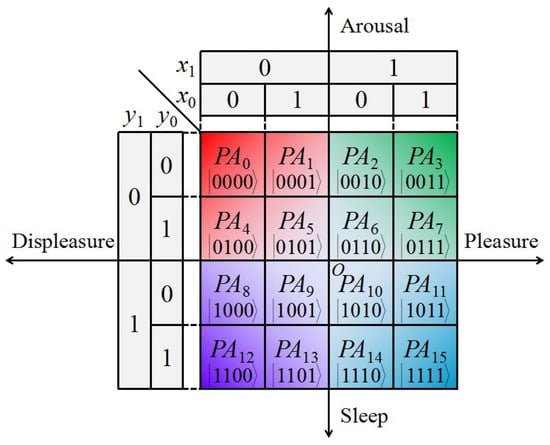
Figure 4.
Description of 16 common states of a robot’s emotions in QPA plane.
Like in Figure 3, there are four quadrants in the QPA plane, which we designate anticlockwise as (Excitement), (Stress), (Depression), and (Calm). The emotions encoded in each quadrant can be represented as an array in the form of . The rows and columns along each plane indicate the levels of the qubits encoding the emotions in the affected area. The relationship between the quadrants and the emotions is formalised in Table 1.

Table 1.
Relationship between the quadrants and emotions.
In addition, according to the layout (i.e., the coordinate values) in the QPA plane (in Figure 4), these emotions are extracted and presented in Table 2.

Table 2.
Description of 16 emotions in Figure 4 and their notations.
3.2. Representation for QES
The formulation of QES is aimed at describing the interplay between quantum emotions of robot(s) in different settings as it changes over time. To account for the transition from one emotional state to another, an extra dimension, i.e., the time axis, is added. Therefore, three qubit sequences are entangled together to encode the QES, which is generally defined as:
where
and
indicate the QPA plane (such as Figure 4) that is used to locate the emotion of the robot at each instant , .
The three-dimensional structure of QES is depicted in Figure 5, wherein the red curve captures the variation in the robot’s emotion at each instant in the QES. For example, indicates the quantum emotion at the time , which itself is a transition from the emotion at the previous instance, . The blue curve in the middle of the QES structure depicts the projection of the quantum emotion and from it the type of emotion exhibited can be extracted instantaneously.
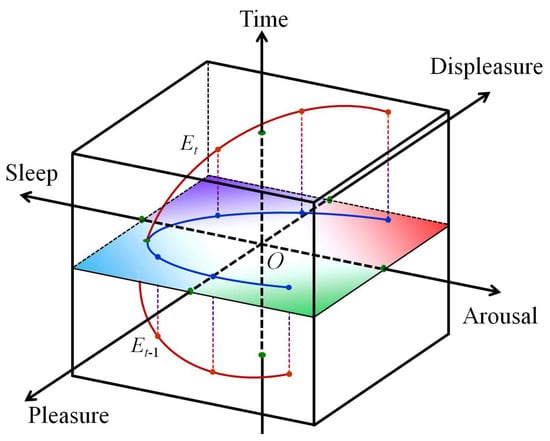
Figure 5.
Graphical description of QES based on the QPA plane in Figure 4.
3.3. Emotion Transition Matrix
When a robot receives some stimuli (e.g., interacting with its atmosphere) from the external world, its current emotional state will change. As elucidated in Equation (9), a robot’s emotion is time-dependent; therefore, the state of a robot’s quantum emotion is meant to be a continuous and time-related variable. That is, at time , the transition of the state of the quantum emotion is related to the state of the quantum emotion at time . Consequently, a unitary matrix (hereafter called emotion transition matrix), , which is derived from the influence of an external stimuli at time k, can be used to describe the transition in the robot’s emotions as well as its use to track future changes in the emotional state. The relationship between the emotion transition matrix and the instantaneous emotions in a QPA is formalised in Equation (12):
where and are the quantum emotions at time and , respectively (as defined in Equation (9)); is the emotion transition matrix that plays a significant role in transmitting the emotion from time to time ; and is a series of emotion transition matrices to describe the changes in a robot’s emotional state. For example, what intrigues are involved in the transition of a robot’s emotion from the state “anger” to the state “relaxation”? Since (in Equation (12)) is a unitary matrix, then for special cases, we can use its adjoint matrix, to recover the current emotion from the previous state .
Using some standard quantum gates and circuit networks (as reviewed in Section 2.1), we can realize some simple emotion transition matrixes to track the changes in a robot’s emotional states. For instance, using the quantum NOT gate, an emotional inverse operation (EIO) is defined as:
where is the number of qubits encoding the QPA plane and X denotes the quantum NOT gate (as in Figure 1) which is presented as:
As an example, we consider the EIO operation (n = 2) applied on the quantum emotion state “anger” whose representation is state . This emotional state will be transformed to a new one where each is inverted to and vice versa. This reverses the roles and changes the corresponding emotional state to , which elicits the “relaxation” emotion.
4. Quantum Emotion Manipulation and Retrieval
In this section, we will present a more elaborate description of the layout of our proposed QES, and then discuss its initialisation, transition, and retrieval.
4.1. Procedure of Quantum Emotion Transition
Our proposed QES is built on the use of several conceptual QC devices, such as a hypothetical emotion compiler (EC), emotion sensor (ES), emotion reader (ER), etc., as required to achieve the initialisation, manipulation, and retrieval of emotions. The EC initialises the QES by transforming the quantum system from its initial state (i.e., an array of states) to a specified emotion state. In addition, the ES transforms the stimulus (such as the atmosphere consisting of multiple individual robots or an environment comprising humans and robots together [5]) received from the external world into a set of unitary operations (i.e., the emotion transition matrix discussed earlier) in a format that is amenable to manipulation using the quantum emotions in the QES. Finally, the ER retrieves the quantum emotional state of the robot at a given time by applying the quantum measurement operations. By combining the operations of these devices into two sub-units, the layout for the quantum emotion transition and retrieval is presented in Figure 6.
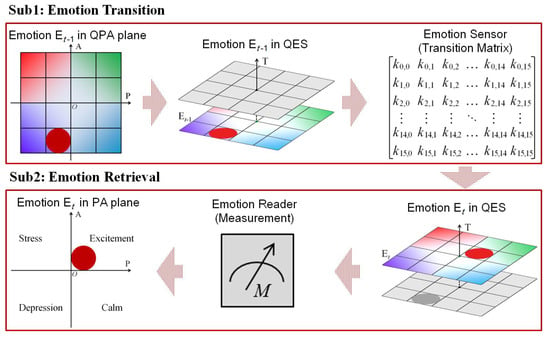
Figure 6.
Quantum emotion transition and retrieval.
In the QES, emotion transition largely depends on the stimulus from the external world (e.g., atmosphere) at any given instance. Assuming the robot’s emotion at time , i.e., , is “tiredness”, then the red dot in the first two figures in Figure 6 (i.e., Sub 1) symbolises the emotion in the QPA plane and QES. In fact, QES is the emotion space that is constructed by recovering a series of computations on the QPA planes according to the time axis. The coloured and greyscale QPA planes (in the middle of Figure 6) are used to distinguish the current emotional state from those at other instances. The ES transforms the stimulus into a corresponding emotion transition matrix (such as the operation EIO in Equation (13)). Generally, this transformation is accomplished by the tensor product operation on a set of unitary operations, e.g., quantum gates in Figure 1, and each operation is evoked using a human and/or robot that facilitate the robot’s emotion entering its next emotional state. Since four qubits are used to represent the emotional state, the corresponding emotion transition matrix will have a dimension. In the earlier example of state signifying the emotion “tiredness”, based on Equation (12), the emotional state at time would be “satisfaction”. In QES, the transformed emotion state at time , i.e., , in QES is shown in the emotion retrieval sub-unit (Sub 2) in Figure 6. Finally, the ER is used to retrieve the quantum emotion state and depict it in the traditional PA plane.
4.2. Quantum Emotion Initialisation and Transition
Like its use to encode quantum images [13], movies [19], and audio [23], utilising quantum mechanics to process emotion imposes the need to first store the emotions as quantum states. This is accomplished during the initialisation procedure for QES, which will now be described.
For a general case, qubits are needed to construct a QES model. Therefore, the first step is to prepare qubits (conventionally as an array of computational basis states [8]) in the form of:
where qubits are used to encode the QPA plane and m qubits are employed to realise the epoch (or time period). We consider the 2-D identity (I) and the Hadamard matrices (H) in Equation (16):
where the tensor product of 2n Identity matrices is denoted as and that of m Hadamard matrices is denoted as similarly with properties in the form:
the operation is applied on the state (in Equation (15)) to initialise the robot’s epoch (i.e., active cycle), and meanwhile, is applied on (also in Equation (15)) to retain the robot’s emotion unaltered (i.e., uninitialised) during the whole epoch.
Applying the transform on produces the state :
We note that, thus far, the time information in the QES has been initialised, i.e., the robot’s epoch or active cycle has been initialised. However, at this instant, there is no emotion state in the QES, but immediately when the robot receives an instantaneous stimulus from the outside world (e.g., at an instant ), the stimulus will be processed by the ES using an emotional transformation matrix . The quantum sub-operation that is used to manipulate emotion state at time is defined using Equation (19):
where that is tensor product with to constrain its operation worked on the specified time instant (time point).
By utilising , the quantum emotion state at time is obtained using:
From Equation (20), it is obvious that the sub-operation affects only the emotion value at time . Therefore, we observe that a series of such sub-operations, where the time varies from 0 to (i.e., ), will be required to construct a whole QES for robots whose procedure is presented as follows:
4.3. Example to Illustrate Quantum Emotion Manipulation
We present a simple example that tracks transitions in a robot’s emotions from (enjoyment), (tension) through to (relaxation) (as shown in Figure 7). The emotion transition matrix used at each instance can be obtained from ES (in Section 4.1). There are 16 QPA planes where, in each plane, the red block indicates the emotion at that instant. Each emotion depicted in the plane is consistent with the contents presented earlier in Table 2. In the QES framework, quantum emotion manipulation is achieved by using the transition matrix to transform each emotion state as shown in the quantum circuit that implements the entire manipulation process is presented in Figure 8.

Figure 7.
Example to illustrate the robot’s emotion transition from “anger” to “relaxation”.
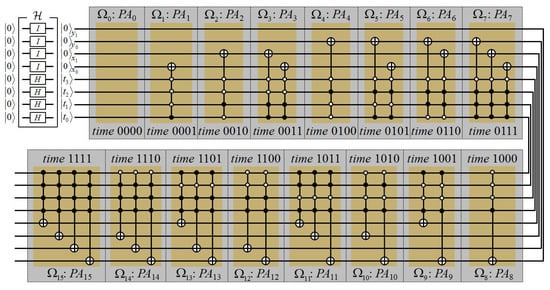
Figure 8.
Circuit constructions for the example in Figure 7.
From the layout of the QES presented in the preceding sections, we see that eight qubits are required to construct the robot’s QES model; for this example, out of this number, four qubits are used to encode the information about emotion (i.e., QPA plane) and four qubits are employed to encode the temporal information about the emotion transition. The symbol used in Figure 8 represents the operation that implements the initialisation process from as presented in Equation (18), whereas the operator is used to transform the current emotion to its next state as described in Section 4.2. Meanwhile, the notation signifies the type of emotion (as presented in Table 2), where . As seen in the circuit construction for this example (in Figure 8), 32 multi-input CNOT gates are used to transform the robot’s emotional state from its initial state, i.e., , to the final state, i.e., .
4.4. Quantum Emotion Retrieval from QES
After the initialisation and manipulation of a robot’s emotion (as discussed in the preceding subsections) the emotions at different instances are stored in the QES. The final step of the QES layout entails using the ER to recover the final emotion state. This is accomplished via quantum measurement operations that are described in the remainder of this section.
In the QES framework, the details of all the emotions of a robot at a given instant are stored in the basis state of qubit sequences. This way, the information can be easily recovered during the emotion retrieval whence each emotion is recovered individually. Similar to their use in [23,24] and discussion in Section 2.1, two quantum measurement operations and M (in Equation (22)) provide the mechanism to retrieve emotion states from epochs (or time periods):
First, executing the quantum measurement operation on the time sequence extracts the corresponding information at time as , which is shown in Equation (23):
and then, the projective measurement operation M is used to recover the emotion information from the quantum state as presented in Equation (24):
The approach outlined ensures that the information about any emotion at an instance can be recovered when needed. Intuitively, this suggests that the original emotion space can also be retrieved from the QES state.
5. Concluding Remarks
The immense power of quantum computation (QC) is exploited to model quantum structure for expression of robot emotions. The proposed quantum emotion space (QES) uses three entangled qubit sequences to store the emotion in a three-dimensional space that consists of a pleasure-arousal (PA) plane and a time axis. This mechanism provides a technique to represent and manipulate a robot’s emotion space, wherein the process of initialisation and transition, which are essential in any manipulation of emotions using the QES, can be realised (using the Identity, Hadamard, and CNOT gates). Based on this, a unitary matrix can be used to track and reverse changes to a robot’s emotions. Finally, the intricacies of the quantum measurement operations employed for emotion retrieval in QES were presented and discussed.
To improve the proposed framework, in future and ongoing work, the results emanating from this study will be extended in the following directions. First, the emotion transition matrix, which is essential for tracking changes in a robot’s emotional state, needs further rigorous study because, in practical cases, the stimuli that influences the changes in emotional states are induced by many factors [25]. Consequently, the emotion transition matrix should be robust enough to model these different cause-effect mechanisms. Second, the 16 common sorts of robot’s emotions that are mapped in the QPA plane are defined by modifying the traditional PA plane. To satisfy the emotional computation of robots under different circumstance (e.g., expectations from the humanoid robot behaviour [26,27]), those emotions might require additional refinement. Third, the use of quantum space of robot emotion to construct a harmonious and natural interface for human-robot interaction should be explored. This will support the use of robots to understand, adapt, and respond to human mood swings as well as other applications in emotional intelligence [28]. Fourth, superposition and entanglement are two fundamental properties of quantum information, it is important that the full benefits of these properties are exploited in modelling the control, planning and reasoning, etc. envisaged in future robots and their interaction with the environment. This will entail necessary modifications to the QES to facilitate definition of more subtle emotions or accelerate the emotional computing tasks. Fifth, the need to adjust the present layout of the QES, including its mathematical groundwork, as required for advanced applications, such as the use of qubots and their integration in user-emotion detection systems for social robots [29] deserve attention. Sixth, noise in quantum gates will limit the size of quantum circuits that can be executed reliably [30]. To realise the QES in a more realistic scenario, the study of quantum error correction is essential in achieving fault-tolerant QC that can deal not only with noise in stored quantum information but with faults in quantum gates, preparation, and measurements. In concluding, we reiterate that while the distance down the road to full scale deployment of quantum computation in robotics is a long one, like many others before it, the formulation of our proposed QES provides a decisive first step in that exploration.
Author Contributions
Conceptualization, F.Y., A.M.I., and S.J.; methodology, F.Y., A.M.I.; writing–original draft preparation, F.Y., S.J., and A.M.I.; writing–review and editing, F.Y. and A.M.I.; supervision, H.Y.; project administration, A.M.I.; funding acquisition, A.M.I.
Funding
This study is sponsored, in full, by the Prince Sattam Bin Abdulaziz University, Saudi Arabia via the Deanship for Scientific Research funding granted to the ACIIS Research group project number 2019/01/9862.
Conflicts of Interest
The authors declare no conflict of interest.
References
- Colman, A. A Dictionary of Psychology, 3rd ed.; Oxford University Press: Oxford, UK, 2009. [Google Scholar]
- Yamazaki, Y.; Hatakeyama, Y.; Dong, F.; Nomoto, K.; Hirota, K. Fuzzy inference based mentality expression for eye robot in affinity pleasure-arousal space. J. Adv. Comput. Intell. Intell. Inform. 2008, 12, 304–313. [Google Scholar] [CrossRef]
- Russell, J.; Fernandez-Dols, J. Reading Emotion from and into Faces—The Psychology of Facial Expression; Cambridge University Press: Cambridge, UK, 1997. [Google Scholar]
- Miwa, H.; Umetsu, T.; Takanishi, A.; Takanobu, H. Robot personality based on the equations of emotion defined in the 3D mental space. In Proceedings of the IEEE International Conference on Robotics & Automation, Seoul, Korea, 21–26 May 2001; pp. 2602–2607. [Google Scholar]
- Liu, Z.T.; Li, D.Y.; Chen, L.F.; Dong, F.Y.; Yamazaki, Y.; Hirota, K. Concept of fuzzy atmosfield for representing communication atmosphere and its application to humans-robots interaction. J. Adv. Comput. Intell. Intell. Inform. 2013, 17, 3–17. [Google Scholar] [CrossRef]
- Hamilton, C. On the Possibility of Robots Having Emotions. Master’s Thesis, Georgia State University, Atlanta, GA, USA, 2014. [Google Scholar]
- Picard, R. Affective computing. LGI Glob. 1997, 1, 71–73. [Google Scholar]
- Nielsen, M.; Chuang, I. Quantum Computation and Quantum Information; Cambridge University Press: Cambridge, UK, 2000. [Google Scholar]
- Lukac, M.; Perkowski, M. Quantum mechanical model of emotional robot behaviors. In Proceedings of the 37th International Symposium on Multiple-Valued Logic, Oslo, Norway, 13–16 May 2007. [Google Scholar]
- Raghuvanshi, A.; Perkowski, M. Fuzzy quantum circuits to model emotional behaviors of humanoid robots. In Proceedings of the IEEE Congress on Evolutionary Computation, Barcelona, Spain, 18–23 July 2010. [Google Scholar]
- Raghuvanshi, A.; Perkowski, M. Using fuzzy quantum logic to learn facial gestures of a Schrödinger cat puppet for robot theatre. In Proceedings of the 38th International Symposium on Multiple-Valued Logic (ISMVL 2008), Dallas, TX, USA, 22–23 May 2008. [Google Scholar]
- Yan, F.; Iliyasu, A.M.; Liu, Z.T.; Salama, A.S.; Dong, F.; Hirota, K. Bloch sphere-based representation for quantum emotion space. J. Adv. Comput. Intell. Intell. Inform. 2015, 19, 134–142. [Google Scholar] [CrossRef]
- Iliyasu, A.M.; Le, P.Q.; Dong, F.; Hirota, K. Watermarking and authentication of quantum images based on restricted geometric transformations. Inf. Sci. 2012, 186, 126–149. [Google Scholar] [CrossRef]
- Yan, F.; Iliyasu, A.M.; Venegas-Andraca, S.E. A survey of quantum image representations. Quantum Inf. Process. 2016, 15, 1–35. [Google Scholar] [CrossRef]
- Benioff, P. Quantum robots and environments. Phys. Rev. A 1998, 58, 893–904. [Google Scholar] [CrossRef]
- Dong, D.; Chen, C.; Zhang, C.; Chen, Z. An autonomous mobile robot based on quantum algorithm. In Lecture Notes Computuer Science; Springer: Berlin/Heidelberg, Germany, 2005; pp. 393–398. [Google Scholar]
- Petschnigg, C.; Brandstötter, M.; Pichler, H.; Hofbaur, M.; Dieber, B. Quantum computation in robotic science and applications. In Proceedings of the IEEE International Conference on Robotics and Automation, Montreal, QC, Canada, 20–24 May 2019. [Google Scholar]
- Iliyasu, A. Roadmap to talking quantum movies: A contingent inquiry. IEEE Access 2019, 7, 23864–23913. [Google Scholar] [CrossRef]
- Iliyasu, A.M.; Le, P.Q.; Dong, F.; Hirota, K. A framework for representing and producing movies on quantum computers. Int. J. Quantum Inf. 2011, 9, 1459–1497. [Google Scholar] [CrossRef]
- Cañamero, D. A hormonal model of emotions for behavior control. In 4th European Conference on Artificial Life; MIT Press: Cambridge, MA, USA, 1997. [Google Scholar]
- Maeda, Y.; Tanabe, N. Basic study on interactive emotional communication by pet-type robot. Trans. Soc. Instrum. Control Eng. 2006, 42, 359–366. [Google Scholar] [CrossRef][Green Version]
- Taki, R.; Maeda, Y.; Takahashi, Y. Effective emotional model of pet-type robot in interactive emotion communication. In Proceedings of the Joint International Conference SCIS & ISIS, Okayama, Japan, 8–12 December 2010; pp. 199–204. [Google Scholar]
- Yan, F.; Iliyasu, A.M.; Guo, Y.; Yang, H. Flexible representation and manipulation of audio signals on quantum computers. Theor. Comput. Sci. 2018, 723, 37–51. [Google Scholar] [CrossRef]
- Yan, F.; Iliyasu, A.M.; Khan, A.R.; Yang, H. Measurements-based moving target detection in quantum video. Int. J. Theor. Phys. 2016, 55, 2162–2173. [Google Scholar] [CrossRef]
- Williams, Q.; Bogner, S.; Kelley, M.; Castillo, C.; Lukac, M.; Kim, D.H.; Allen, J.S.; Sunardi, M.I.; Hossain, S.; Perkowski, M. An emotional mimicking humanoid biped robot and its quantum control based on the constraint satisfaction model. In Proceedings of the 16th International Workshop on Post-Binary ULSI Systems, Oslo, Norway, 13–16 May 2007. [Google Scholar]
- Lukac, M.; Giesecke, N.; Hossain, S.; Perkowski, M.A. Quantum behaviors: Synthesis and measurement. In Proceedings of the 37th International Symposium on Multiple-Valued Logic, Oslo, Norway, 13–16 May 2007. [Google Scholar]
- Lukac, M.; Perkowski, M. Inductive learning and quantum behaviors. Facta Universitatis-Ser. Electron. Energ. 2007, 20, 561–586. [Google Scholar] [CrossRef]
- Raghuvanshi, A.; Fan, Y.; Woyke, M.; Perkowski, M. Quantum robots for teenagers. In Proceedings of the 37th International Symposium on Multiple-Valued Logic, Oslo, Norway, 13–16 May 2007. [Google Scholar]
- Alonso-Martin, F.; Malfaz, M.; Sequeira, J.; Gorostiza, J.; Salichs, M. A multimodal emotion detection system during human–robot interaction. Sensors 2013, 13, 15549–15581. [Google Scholar] [CrossRef] [PubMed]
- Preskill, J. Quantum computing in the NISQ era and beyond. Quantum 2018, 2, 79. [Google Scholar] [CrossRef]
© 2019 by the authors. Licensee MDPI, Basel, Switzerland. This article is an open access article distributed under the terms and conditions of the Creative Commons Attribution (CC BY) license (http://creativecommons.org/licenses/by/4.0/).